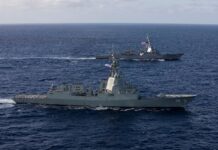By Sam Roggeveen*
It’s inevitable that, when the US sails warships through the Taiwan Strait, it will be interpreted as a broader diplomatic statement or even a protest – in this case, perhaps about North Korea, or the US–China trade spat. But these transits are more common than you might think.
According to Reuters sources, the US Navy does this sort of thing regularly. Granted, the US does not send its most powerful ships; it has been more than ten years now since the US sailed a carrier through the Strait. In this latest case at the weekend, it was two destroyers which made the passage. Still, given the fairly routine nature of the operation, we should assume that the US is not trying to make a big statement about trade or North Korea, and that this is instead just a continuation of an establised practice designed to show support for Taiwan.
In 1996, the US Navy could sail through the Taiwan Strait because China could do little to stop it; now China chooses to do nothing to stop it.
If that’s the case, the US is merely signalling that it has not changed its mind about Taiwan policy, even though much has changed in the relative power balance between the US, China, and Taiwan. In 1996, in response to Chinese missile tests designed to intimidate Taiwan during an election year, the US staged what Wikipedia calls “the biggest display of American military might in Asia since the Vietnam War”, including sailing an aircraft carrier and an amphibious assault ship through the Strait.
But whereas in 1996 the US Navy would have been confident that its defences were strong enough to stop any Chinese threat to such a fleet, that is now clearly not the case. The modernisation of China’s maritime forces has been dramatic over that time, particularly close to Chinese shores where, in a conflict, the defences of any hostile vessel would be quickly overwhelmed by Chinese anti-ship weapons fired from land, air, and sea.
To put it more bluntly, in 1996 the US Navy could sail through the Taiwan Strait because China could do little to stop it; now China chooses to do nothing to stop it. That puts the US in a position where, instead of such a transit being an affirmation of continued support to Taiwan, it becomes something of a ritual observed largely because not observing it would publicly acknowledge the truth about the shifting power balance, which would spook the Taiwanese and encourage Beijing.
Still, there’s an excellent chance that, whereas in 1996 America’s affirmations of support for Taiwan were genuine, they are now a bluff. It’s not that the US would necessarily lose if it supported Taiwan in a war with China; it’s just that the likely cost of victory has so dramatically increased that the US is far less likely to risk it. That fact should be obvious to Taiwan, and no number of US warship transits through the Taiwan Strait can change it.
* Sam Roggeveen is Director of the Lowy Institute’s International Security Program, and a Visiting Fellow at the Strategic and Defence Studies Centre, Australian National University. Before joining the Lowy Institute, Sam was a senior strategic analyst in Australia’s peak intelligence agency, the Office of National Assessments.
Republished with permission of the Lowy Institute



